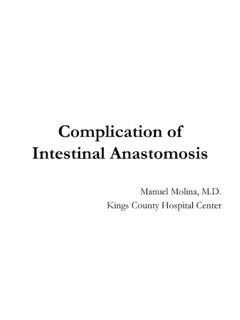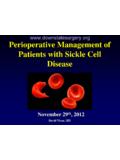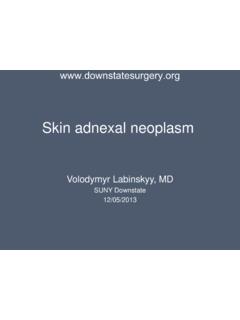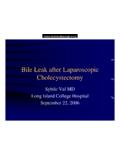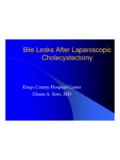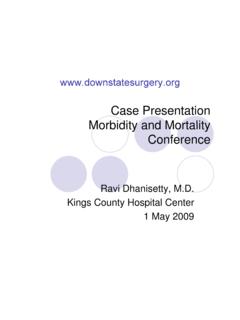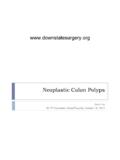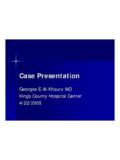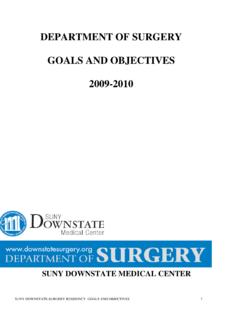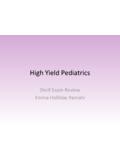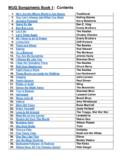Transcription of MANAGEMENT OF ESOPHAGEAL ATRESIA AND …
1 MANAGEMENT OF ESOPHAGEAL ATRESIA AND tracheo - ESOPHAGEAL FISTULAW assimAbiJaoude, PGY5 Long Island College HospitalJanuary 3 days old baby girl 32 weeks gestation Emergency C/section due to PROM and fetal distress Birth weight 1670 g APGAR 5 @ 1mn and 7 @ 5mn IVF with a DONOR EGG DONOR MOTHER-25 yo healthy CARRIER/BIRTH MOTHER- 50 yo, h/o RESPIRATORY DISTRESSI ntubatedSurfactantExtubatedthe second day IN THE MEANWHILEP assed meconiumNeonatal jaundice PHOTOTHERAPYAmp/Gent for presumed SAME NIGHTR espiratory distress/labored breathingNCPAP trial IntubationNGT attempted twice w/o successABDOMINAL EXAMINATION Intubated Abdomen distended Rectal exam- meconium No other anomalies detected Labs- within WORK UPCARDIAC ECHO PDAwith left to right shunt OSTIAL ASD with left to right shuntRENAL ULTRASOUND C ESOPHAGEAL ATRESIA with distal tracheo - ESOPHAGEAL fistula proximal pouch at T4-T5 ASSOCIATED ANOMALIES Vertebral malformations PDA MANAGEMENTG astrostomyBroviaccatheter placementRight
2 Posterolateralthoracotomy, closure of TE fistula and end-to-end primary , CLOSUREOFTE FISTULAAND END-TO-ENDPRIMARYESOPHAGO-ESOPHAGOSTOMY Left lateral decubitus Right posterolateral thoracotomythrough the 4thintercostal space Retropleuraldissecctionunderwent Ligation/divisonof the azygosvein The gap between the 2 ESOPHAGEAL stumps was about The fistula was identified, divided and closed with interrupted 5/0 prolene sutures Mobilization of proximal , CLOSUREOFTE FISTULAAND END-TO-ENDPRIMARYESOPHAGO-ESOPHAGOSTOMY Tension-free end-to-end esophago-esophagostomywith interrupted 3/0 silk, posterior row first then anterior after placement of a silastictube through the anastomosisup to the mouth 8 Fr chest tube Penrose drain next to the anastomosis Closure in Extubatedon POD#4 TPN post-op POD#9- Gastrograffinswallow showed a small leak Tube feeds started and tolerated Chest tube removed but Penrose left in OF ESOPHAGEAL ATRESIA AND tracheo - ESOPHAGEAL BACKGROUND1697 Firstdescription of an ESOPHAGEAL atresiawith typical TE fistula by Thomas Gibson in the 5thedition of The Anatomy of Humane Bodies Epitomized1899 First permanent gastrostomyfor a patient with EA by Hoffman1936-19391936/1937 Lanmanperformed 4 primary ESOPHAGEAL repairs in infants with EA-TEF1939 1streport of EA-TEF
3 Treated with fistula ligation and primary ESOPHAGEAL anastomosisby Robert Shaw 1941 Cameron Haight(University of Michigan) performed the first successful repair of EA-TEF via a left extrapleuralapproach w/ fistula ligation and a single layered ESOPHAGEAL BACKGROUND 1943-Haight revised the procedure to a right thoracotomy Between 1939 and 1969, he cared for more than 284 infants with EA and reported an overall survival of 52%Cameron Haight, embryology- budding of the tracheal primordiumfrom the primitive esophagus and formation of the tracheoesophagealseptum which begins caudally and ends occlusion and failure of recanalisationof the intestinal lumenCephalic NEUROCRISTOPATHY and defective pharyngeal pouch developmentAbnormal growth of the esophagus into the trachea and abnormal lung morphogenesis (it was found that the distal esophagus and fistula tract are of respiratory origin) Incidence 1/2440 to 1/4500 births (Europe> USA and Australia) Male/female to (depending on the type) Risk factorsFirst pregnancyMothers younger than 20 Advanced maternal ASSOCIATIONS Chromosomal abnormalities (tri 13 and 18)
4 - 6-10% Teratogens-OCPs, Thalidomide, estrogen/progesterone Hyperthyroid and diabetic mothers Genetic syndromes-DiGeorge, Polyspleniasequence, Holt-Oramsyndrome, Pierre-Robin syndrome Familial- if 1 child affected risk is ; if more than 1 child affected risk is 20%; if one parent affected risk 3-4% ANOMALIESC ardiovascular35%Account for most of the death associated with EA; VSD (19%) and ASD (20%) most common; right sided aorta 4%Genitourinary24%Renal agenesis orHypoplasia(1%); hypospadias, exstrophy;..Gastrointestinal24%Anorectal malformations (14%);duodenal ATRESIA (2%); malrotation (4%)Neurologic12%Neural tube defects ( ): hydrocepha-lus ( ); holoprosencephaly ( )Musculoskeletal20%Limb anomalies (15%); vertebral anomalies (17%)VACTERL20%Vertebral, Anorectal, Cardiac, tracheo - ESOPHAGEAL , Renal, LimbOverall Incidence50-70%50-70% at least one malformation; most common with EA w/o TEF and least common with H-type ANOMALIES VACTERL-20% mainly with EA-TEFmay have also other midline defects (cleft lip/palate 2%.)
5 Sacral agenesis 2%) VACTERL-Hwith congenital hydrocephalus Unilateral pulmonary agenesis-rare (37 cases since 1874) Tracheobronchial abnormalities-47% (ectopic or absent right upper lobe bronchus, congenital bronchial stenosis, tracheal malformations) Abnormalities in vagal : ANATOMICTYPE%GROSSTYPE1. EAw/ distal EA w/o TEF w/o EA w/ TEF to both EA w/ proximal : PROGNOSTICGROUPSURVIVALWATERSTON CLASSIFICATIONA100%Birthweight >2500g and otherwise healthyB85%Birth weight 2000-2500gand well OR higher weight w/ moderate associated anomalies (non cardiac plus PDA, VSD or ASD)C65%Birth weight <2000g OR higher with severe associated Cardiac anomaliesWaterston s 1962 classification separated patients into groups based on birth weight, pneumonia and congenital anomaliesGroup A were treated with immediate repairGroup B were treated with delayed repair Group C were treated with staged : PROGNOSTICGROUPSURVIVALI.
6 Birth weight > 1500g w/o major CHD97% weight <1500g or major CHD59%III. Birth weight <1500g and major CHD22%SPITZ Classification- most commonly used DIAGNOSIS Rarely diagnosed Findings-small or absent stomach bubbleassociated maternal polyhydramnios Predictive value only 20-40% Fetal MRI can FINDINGS Earliest sign-Excessive salivation First feeding followed by regurgitation, coughing, choking Other manifestationsCyanosis w/ or w/o feedingRespiratory distressInability to swallowInability to pass a suction catheter If distal fistula abdomen distends + chemical pneumonitis compression on the chest + worsening respiratory XR showing a Replogletube in the ml of barium injected in upper pouch confirm the A small upper pouch suggests a proximal TEF Air in the stomach confirms a distal TEF Absence of air in the abdomen represents EA w/o TEF TEF w/o EA (H-type)
7 High index of suspicion neededBarium esophagographyin the prone positionConfirm with bronchoscopy or TESTS ECHOCARDIOGRAPHY RENAL ULTRASOUND CHROMOSOMAL MANAGEMENT SUMP CATHETER in upper ESOPHAGEAL pouch Position infant to prevent reflux and aspirationUpright sitting positionHead-up prone position Broad spectrum antibiotics IVF ET intubation if needed but AVOID if : ESOPHAGEALATRESIAWITHDISTALTRACHEOESOPHA GEALFISTULAR ight posterolateral thoracotomyA left thoracotomymay be needed in case of right sided archChest entered through the fourth intercostal spaceExtrapleuralapproach is preferred to minimize the risk of empyemain case of leakAzygosvein is ligatedFistula, distal pouch and proximal pouch : part of esophagus and fistula circumferentially dissected5/0 or 6/0 prolenesutures are placed and the fistula dividedCheck for air leakB.
8 Distal dissection should be limitedTraction suture proximally to mobilize proximal endPossible identification of a proximal TEFB eware of vagalbranchesC. May need to do a proximal circular myotomyto further mobilize the proximal : ESOPHAGEALATRESIAWITHDISTALTRACHEOESOPHA GEALFISTULAS ingle layer anastomosiswith 5/0 or 6/0 interrupted suture (silk vspolypropelene or polyglycolicacid)Corner stitches tied on the outsidePosterior row of interrupted sutures tied on the insideComplete anastomosisover a : ESOPHAGEALATRESIAWITHDISTALTRACHEOESOPHA GEALFISTULATHORACOSCOPIC REPAIR OF EA-TEFB enefits includeSuperior visualizationImproved cosmesisDecreased morbidity of neonatal thoracotomy(winging of scapula, scoliosis, chronic pain, chest wall assymetry.)
9 Limited studies and follow upPreliminary resultsStenosisrate 30-50%Leak rate 12-15%GERD rate 30-50%OR time 2-4 REPAIR OF tracheo - ESOPHAGEAL FISTULAS: A CASE-CONTROLMATCHED STUDYALTOKHAIS ET AL. J PEDSURG2008 43: 805-809 Between 1990 and 2006 22 neonates underwent TR 23 matched controls underwent open repairTR (n=23)OCR (n=22)POR time (mn) ( )3 ( ).725 Strictures2 ( )4 ( ).414 Early complications1 ( )6 ( ).047 Mortality1 ( )2 ( ). REPAIR OF tracheo - ESOPHAGEAL FISTULAS: A CASE-CONTROLMATCHED STUDYALTOKHAIS ET AL. J PEDSURG2008 43: 805-809 Time to full enteral feeding TR 10 days COR days CONCLUSIONS Comparable operative times Comparable leak and stricture rates Comparable rates of mediastinits, pneumonias or death despite the transpleural approach Lower rate of early compplications Earlier : ESOPHAGEALATRESIAWITHDISTALTRACHEOESOPHA GEALFISTULAR espiratory distress w/ ET intubation gastric distention and more respiratory distressGastric division, banding of gastroesophageal junction or placing ET tube below the level of the fistulaBronchoscopicplacement of a Fogarty catheter in the fistula Emergency gastrostomy- consider underwater.
10 LONGGAPEA Staged procedure starting with a gastrostomy The gap tends to lessen during the first few months of life due to spontaneous growth Non-operative methods to help shrink the gapUpper pouch bougeinagefor 6-12 weeksUpper and lower pouch bougeinageElectromagnetic field applied to 2 pieces of metal placed in both : LONGGAPEAO perative approaches Threads with silver olives Multistaged extrathoracicelongation technique FOKER technique-Traction sutures on both ends of the esophagus that exit through the chest wall and are pulled in opposite : LONGGAPEACIRCULAR MYOTOMY ComplicationsWorsens ESOPHAGEAL motilityEsophageal leakImpaction of food particles in the myotomized segmentBallooning of the myotomizedsegment- pseudodiverticulum VariationsSpiral myotomyShort horizontal : LONGGAPEA Other approaches Creation of a full thickness anterior or posterior flap (Gough et al.)

